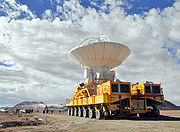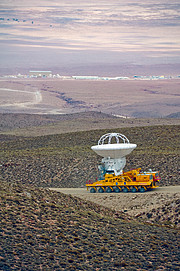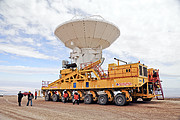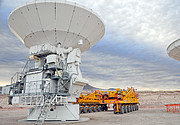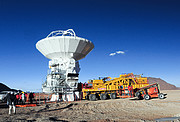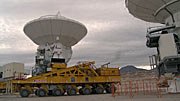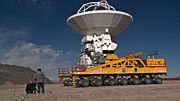Persbericht
Eerste ALMA-antenne naar 5000 m hoogte gebracht in Chileense Andes
23 september 2009
De eerste schotel van de Atacama Large Millimeter/submillimeter Array (ALMA) is naar de 5000 meter hoge Chajnantor-hoogvlakte gebracht in het Chileense Andes-gebergte. Het 100 ton zware gevaarte is met een speciaal gebouwd tranportvoertuig, genaamd Otto, vervoerd naar de Array Operations Site, waar door de extreem droge lucht ideale condities bestaan voor sterrenkundige waarnemingen.
De omstandigheden op de Chajnantor-hoogvlakte zijn niet zo ideaal om te verblijven; er is maar half zoveel zuurstof als op zeespiegelniveau. Om die reden worden de ALMA-schotels geassembleerd en getest op de Operations Support Facility die op 2900 meter ligt. Vanuit dit basiskamp is de antenne naar 5000 meter hoogte getransporteerd.
ALMA-directeur Thijs de Graauw noemt het transport van de eerste antenne “een huzarenstuk, waarmee de geboorte van ‘s werelds meest ambitieuze aardse observatorium weer een stap dichterbij is gekomen”.
ALMA wordt het grootste en hoogst gelegen observatorium ter wereld. Na voltooiing zal het bestaan uit 66 schotelantennes: 54 schotels met een middellijn van 12 meter (voor de helft gebouwd in Noord-Amerika en voor de andere helft in Europa) en 12 Japanse schotels met een middellijn van 7 meter. ALMA gaat het heelal waarnemen op (sub)millimetergolflengten, en zal naar verwachting veel nieuwe informatie opleveren over de geboorte van sterrenstelsels, sterren en planeten.
De Europese ALMA-projectmanager Wolfgang Wild prijst de inbreng van de internationale partners aan ALMA. “De schotel die nu naar boven is gebracht, is door Japan geproduceerd, het transportvoertuig is Europees en de ontvangstapparatuur in de antennes Noord-Amerikaans, Europees en Aziatisch.”
De ALMA-antenne is op de hoogvlakte op een docking-station gezet en aangesloten op het stroom- en glasvezelnetwerk. Dat is met een nauwkeurigheid van enkele millimeters gebeurd. De antennes zijn zo ontworpen dat ze bestand zijn tegen de extreme weercondities op Chajnantor, met temperaturen van +20 tot -20 Celsius.
De 66 schoteleantennes komen verspreid over de hoogvlakte te staan over een afstand van maximaal 18,5 kilometer, en vormen tezamen een gigantische telescoop. De antennes kunnen met de grote transportvoertuigen worden verplaats en herschikt voor diverse soorten waarnemingen.
Begin 2010 zullen de eerste drie antennes op hun plek staan. De eerste wetenschappelijke observaties zullen naar verwachtingen in de tweede helft van 2010 plaatsvinden. Het licht dat ALMA gaat opvangen, komt van de oudste en verste objecten in het heelal: wolken van gas en stof waarin nieuwe sterren worden geboren, en verre sterrenstelsel aan de ‘rand’ van het waarneembare heelal. Dit deel van het universum is relatief onontgonnen op submillimeter golflengten. Dit soort waarnemingen vereist extreem droge lucht en zeer geavanceerde ontvangers in de telescoopschotels.Meer informatie
ALMA is een project waarin Europa, Noord-Amerika en Oost-Azië deelnemen, in samenwerking met Chili. De Europese Zuidelijke Sterrenwacht ESO is de Europese partner in het mondiaal project. Nederland is ee van de 14 deelnemers in ESO. De Europese Zuidelijke Sterrenwacht ESO beheert de grote telescopen in het noorden van Chili, waaronder de Very Large Telescope op Mount Paranal.
Links
ALMA Observatory: http://www.almaobservatory.org/
Contact
Wolfgang Wild
ESO
Garching, Germany
Tel: +49 89 3200 6716
E-mail: wwild@eso.org
Douglas Pierce-Price
ESO
Garching, Germany
Tel: +49 89 3200 6759
E-mail: dpiercep@eso.org
Marieke Baan (Perscontact Nederland)
ESO Science Outreach Network
en NOVA Informatie Centrum
Tel: +31(0)20-5257480
E-mail: eson-netherlands@eso.org
Over dit bericht
| Persberichten nr.: | eso0935nl |
| Legacy ID: | PR 35/09 |
| Naam: | Atacama Large Millimeter/submillimeter Array |
| Type: | Unspecified : Technology : Observatory : Telescope |
| Facility: | Atacama Large Millimeter/submillimeter Array |
Our use of Cookies
We use cookies that are essential for accessing our websites and using our services. We also use cookies to analyse, measure and improve our websites’ performance, to enable content sharing via social media and to display media content hosted on third-party platforms.
ESO Cookies Policy
The European Organisation for Astronomical Research in the Southern Hemisphere (ESO) is the pre-eminent intergovernmental science and technology organisation in astronomy. It carries out an ambitious programme focused on the design, construction and operation of powerful ground-based observing facilities for astronomy.
This Cookies Policy is intended to provide clarity by outlining the cookies used on the ESO public websites, their functions, the options you have for controlling them, and the ways you can contact us for additional details.
What are cookies?
Cookies are small pieces of data stored on your device by websites you visit. They serve various purposes, such as remembering login credentials and preferences and enhance your browsing experience.
Categories of cookies we use
Essential cookies (always active): These cookies are strictly necessary for the proper functioning of our website. Without these cookies, the website cannot operate correctly, and certain services, such as logging in or accessing secure areas, may not be available; because they are essential for the website’s operation, they cannot be disabled.
Functional Cookies: These cookies enhance your browsing experience by enabling additional features and personalization, such as remembering your preferences and settings. While not strictly necessary for the website to function, they improve usability and convenience; these cookies are only placed if you provide your consent.
Analytics cookies: These cookies collect information about how visitors interact with our website, such as which pages are visited most often and how users navigate the site. This data helps us improve website performance, optimize content, and enhance the user experience; these cookies are only placed if you provide your consent. We use the following analytics cookies.
Matomo Cookies:
This website uses Matomo (formerly Piwik), an open source software which enables the statistical analysis of website visits. Matomo uses cookies (text files) which are saved on your computer and which allow us to analyze how you use our website. The website user information generated by the cookies will only be saved on the servers of our IT Department. We use this information to analyze www.eso.org visits and to prepare reports on website activities. These data will not be disclosed to third parties.
On behalf of ESO, Matomo will use this information for the purpose of evaluating your use of the website, compiling reports on website activity and providing other services relating to website activity and internet usage.
Matomo cookies settings:
Additional Third-party cookies on ESO websites: some of our pages display content from external providers, e.g. YouTube.
Such third-party services are outside of ESO control and may, at any time, change their terms of service, use of cookies, etc.
YouTube: Some videos on the ESO website are embedded from ESO’s official YouTube channel. We have enabled YouTube’s privacy-enhanced mode, meaning that no cookies are set unless the user actively clicks on the video to play it. Additionally, in this mode, YouTube does not store any personally identifiable cookie data for embedded video playbacks. For more details, please refer to YouTube’s embedding videos information page.
Cookies can also be classified based on the following elements.
Regarding the domain, there are:
- First-party cookies, set by the website you are currently visiting. They are stored by the same domain that you are browsing and are used to enhance your experience on that site;
- Third-party cookies, set by a domain other than the one you are currently visiting.
As for their duration, cookies can be:
- Browser-session cookies, which are deleted when the user closes the browser;
- Stored cookies, which stay on the user's device for a predetermined period of time.
How to manage cookies
Cookie settings: You can modify your cookie choices for the ESO webpages at any time by clicking on the link Cookie settings at the bottom of any page.
In your browser: If you wish to delete cookies or instruct your browser to delete or block cookies by default, please visit the help pages of your browser:
Please be aware that if you delete or decline cookies, certain functionalities of our website may be not be available and your browsing experience may be affected.
You can set most browsers to prevent any cookies being placed on your device, but you may then have to manually adjust some preferences every time you visit a site/page. And some services and functionalities may not work properly at all (e.g. profile logging-in, shop check out).
Updates to the ESO Cookies Policy
The ESO Cookies Policy may be subject to future updates, which will be made available on this page.
Additional information
For any queries related to cookies, please contact: pdprATesoDOTorg.
As ESO public webpages are managed by our Department of Communication, your questions will be dealt with the support of the said Department.

